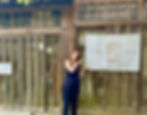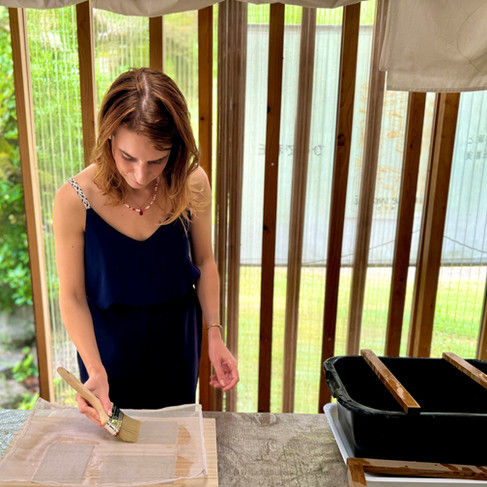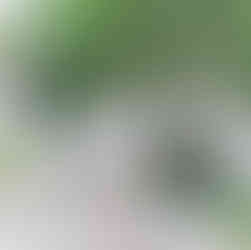Washi Paper Workshop
HINODE WASHI

WOULD YOU LIKE TO
EXPERIENCE MAKING WASHI
(TRADITIONAL JAPANESE PAPER)
FROM TREES?
Hinode washi also uses water from a well for the papermaking process.

“Hinode Washi” Is Located In The Vast Nature Just 90 Minutes Away From Shinjuku Station
In the summer, fireflies dance around the river in front of the workshop, and autumn leaves are stunningly beautiful in the fall. The large property also cultivates mulberry trees, used as the raw material for washi.

The Handmade Workshop shed Blending into the Surrounding Greenery
You know you are in good hands when you arrive at Hinode Washi. The staff built the wooden shed where the workshop takes place, which blends beautifully with the surrounding garden. When you enter, natural light bathes the room. With a view of the garden and the sounds of crickets in the distance, it is the best place to reconnect with nature through a washi-making experience.
A WIDE VARIETY OF EXPERIENCE COURSES AVAILABLE
The papermaking experience courses include raw material preparation and are offered in one-hour and two-hour courses. Depending on what you want to make, you can choose from various options, such as creating drawings through papermaking, washi lanterns, handmade book covers, and more.
Although I had already made washi paper before, I had never encountered a workshop that guided me through all the steps, from the freshly cut branches to the paper itself. It was a truly hands-on and exciting experience, knowing that the outcome of my paper depended entirely on me. Whether it turned out well or not, the fact that I was fully responsible made it all the more enjoyable.

MAKING THE WASHI RAW MATERIALS FROM MULBERRY (KOZO)
You will peel the bark from mulberry (kozo) trees, used as the raw material for washi.
Peeling the skin of the bark from the branches was oddly satisfying. Although it was easy at first, you must focus more towards the end when taking out the little bits left so that your paper remains spotless.

AFTER PEELING THE BARK, IT IS POUNDED INTO FINE FIBERS
The mulberry fibers are thick, long, and durable, making them ideal raw materials for other purposes, such as shoji and art paper.
I was curious about how to turn hard material into soft material, and to do so, you must pound the raw bark several times until it becomes a soft fiber.

A RAW MATERIAL PREPARATION EXPERIENCE THAT TEACHES HOW PAPER IS MADE
Usually, mulberry raw materials are prepared only in winter, but you can still experience it at Hinode Washi at any time of the year.
Life in the countryside is busy year-round, but in winter, people tend to immerse themselves in indoor crafts like washi-making as outdoor activities decrease. Since this workshop is offered throughout the year, it would be a wonderful experience no matter the season!

HAVE YOU EVER DRAWN WATER FROM A WELL?
Creating paper surrounded by nature offers the opportunity to connect with Japan's traditional culture and history. In today's fast-paced world of technological advancements, this feels like a valuable and meaningful experience.
I did not expect to feel so excited about drawing water from a well, but it was one of the best parts of the experience. You rarely see such traditional equipment anymore, let alone use it!
THE BEAUTIFUL TEXTURE OF THE WASHI IS SURFACING
The mulberry fibers, which have been thoroughly loosened using well water and adhesive, are poured in.
Seeing the soft ball of smashed bark from a mulberry tree dissolve in freshwater was fascinating. After adding the adhesive, I poured the liquid onto the paper frame several times, and gradually, my handmade washi paper started to take form.
YOU CAN MAKE WASHI AT HOME AS WELL
Hinode Washi also offers a “Home Papermaking Kit.” This set includes a papermaking screen, mulberry fibers, adhesive, and other materials for authentic papermaking. It has video tutorials and a photo-filled instruction manual, so beginners can easily make it.
After learning to make washi paper with the staff, I felt confident enough to try this again at home and even show my friends how to do it!

HANDMADE WASHI POSTCARD
You can create three handmade washi postcards at once by embedding flowers and plants or drawing pictures during the papermaking process.
I was pleased with how my washi papers turned out! There are many courses to choose from, and next time, I may try a more complex one. The workshop also has a little shop corner where you can see many washi papers, from incense sticks to lanterns and even hats!
NEW PAPERMAKING TECHNIQUES ADAPTED TO MODERN LIFESTYLES
Although traditional washi making involves complex processes and skilled craftsmanship, “Hinode Washi” has adapted the papermaking techniques with modern methods, allowing both children and adults to enjoy the experience in a fun and accessible way.
While browsing the shop, the staff explained that the colored washi papers were made by directly dyeing the bark during the washi-making process, not after! The colors were graceful. They would make a perfect gift to take back home. Since washi paper isn’t heavy, you will always have some room for them in your luggage.

“PAPERS ARE MADE FROM TREES”
Unlike traditional papermaking, Hinode Washi uses creative ideas to craft many items, making it a special place where you can truly appreciate the meaning of the phrase, “Papers are made from trees.”
Hinode Washi offers an experience that is hard to get our hands on nowadays. Even if you like crafting and D.I.Y workshops, you often make a mandatory stop at a shop. Here, you learn to create something by yourself using what nature provides: mulberry trees and freshwater.

Comment from the reporter!
Since Hinode Washi is only accessible by taxi, it is recommended that you arrive a bit early. When making a reservation, be sure to check the website thoroughly, as they offer a variety of courses! Inside the workshop is a souvenir corner where you can purchase unique items like washi postcards, which can even have your picture printed on them. These items are lightweight and easy to carry, perfect for souvenirs!
Reporter
Oceane ( from France )
Residing in Japan for more than 2 years
Washi Paper Workshop
HINODE WASHI
地点
6436 Okuno, Hinode-machi, Nishitama District, Tokyo Prefecture
使用权
About 10 minutes by taxi from Musashi-Itukaichi Station
费用
・1-hour experience course: 2,500 yen~7,500 yen
・2-hour experience course: 2,500 yen~8,000 yen
营业时间
10:00~16:00
Closed: Tuesdays and Wednesdays
东京地图

About 1-hour 15-minute
from Shinjuku Station to Musashi-Itsukaichi Station / JR Chuo・Ome Line




















